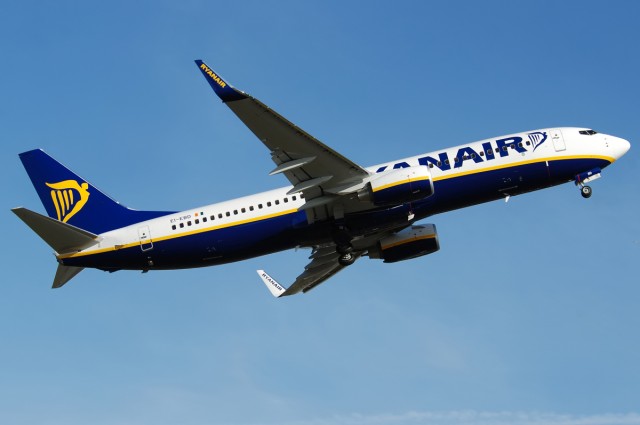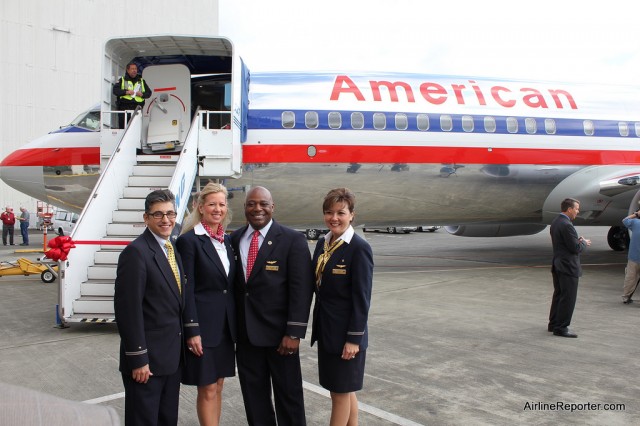
American Airlines pioneerd the frequent flier program. Could they have ever known people would just fly for miles? Photo by David Parker Brown.
This is a multi-part (or multi-leg) series on mileage runs. Future parts will be posted soon.
Everyday people are up in the sky, flying to and from their destination inside a metal tube. But why? For some it is business, for others they are off on vacation to a faraway destination. It could also be either a fun or reluctant trip to visit their family. But there are another group of people who are out there flying: the mileage runners. These are the folks who are not flying to get to a destination, they are flying to earn miles via an airline’s rewards system to get status and those benefits to come with it.
Airline rewards programs are nothing new. American Airlines was the second airline to offer a frequent flyer scheme, behind Texas International Airways. AAdvantage was born in 1981, giving an incentive back to those who flew often with the airline. It was a pretty basic program back then, compared to now.
These days the frequent flier schemes offer more rewards and in some cases can be hugely profitable for the airline. Some programs offer bigger rewards than others; the extreme likely being able to use Virgin Atlantic miles (2,000,000 to be exact) to enter a drawing to travel to space on Virgin Galactic.
Earning these miles can come from a number of ways not just by flying; credit cards and staying at certain hotel chains can help. As the balance builds so does the desire to earn more – it becomes almost an addiction
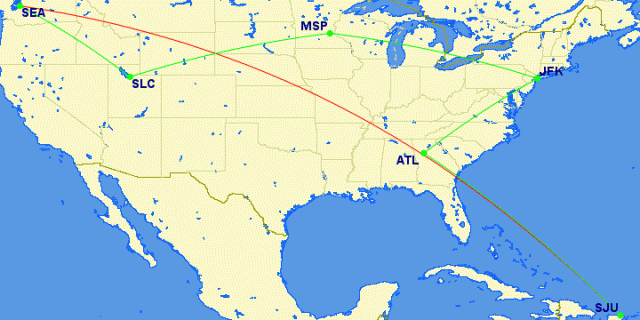
Why Fly the Red Route when you could fly the Green?
How do you earn the big points? Well, the fun way is to fly! It is quicker to rack up points than you might think. If your program awards you one point per mile and you fly a 1000 miles, then that is 1000 points right?
But what if that flight was cheaper via another city, which added 500 miles to your trip? Most passengers might avoid that option, but that’s a 50% bonus. What if you could make that one way flight from Seattle to San Juan (in Puerto Rico) go via Salt Lake, Minneapolis, New York and Atlanta, all for the same price? Does that make you crazy? No it makes you a mileage runner.
Although someone out there surely started the trend, there is now a community of people now who mileage run for a number of reasons. Sites like Flyertalk or Milepoint contain a wealth of knowledge as users share the best tips, tricks and ways of just getting through your flights.
The best thing that these sites offer for the mileage runner are the sections dedicated to finding the best mileage runs. Be it a multi-leg flight from the west coast to Japan, via Hawaii, Guam and Hong Kong or from San Francisco to New Zealand, via Dubai and Melbourne.
Be aware that each airline program is different and have rules that you need to follow. Some of these runs might set you back $500-600, but nett you, with bonuses, 20,000 to 30,000 points by the time you’re finished. If you have vouchers from delays or bumps, then this can bring that price down even more. There are even some bloggers who give great guides on actually booking these complicated mileage runs.
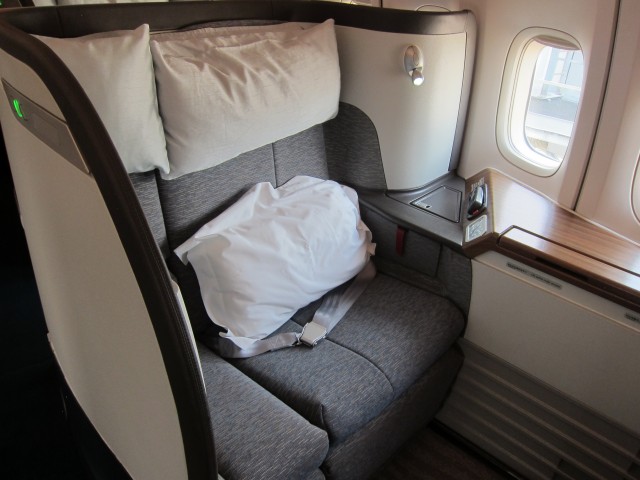
Cathay Pacific First Class “Suite” – Photo: Ben Schlappig
You are probably thinking to yourself, ’œwhy would I put myself through all of that — this can’t be worth it.’ Look at this way. You put yourself through all of this hassle of researching the bargain basement fares, spend more time taking the long way to your destination, but be sure to keep targeting one airline. It doesn’t take long for you and your traveling companion to earn 140,000 points each with an airline , which is not all that hard if you fly for a living (or churn a few credit cards, but that’s another story). Sure you could use it for a few first class trips to Vegas or a number of coach tickets somewhere, but why not drop it in one hit on something aspirational.
Most airlines allow you to redeem your 140,000 points for flights with some of its partners. There are quite a few options with that many miles. Like a nice trip to the West Coast of the USA to Africa… via Hong Kong. That may sound like torture, sure. But even the non AvGeeks among us would want to fly with the seat seen above on Cathay Pacific.
For 140,000 points you can fly round trip from San Francisco to Johannesburg with Cathay Pacific. That’s four flights, 14 hours each, with a stopover allowed in each direction. That is about $40,000 worth of first class flights — maybe that hassle does not look that bad anymore.
So, why mileage run? It is not just about earning points. It is about what you can do with those points. Next time you’re flying your way somewhere, think to yourself. Could I be earning my points a little bit better?
This series will continue with additional insights on mileage running — stay tuned.
 |
This story written by…Malcolm Muir, Lead Correspondent. Mal is an Australian Avgeek now living and working in Seattle. With a passion for aircraft photography, traveling and the fun that combining the two can bring. Insights into the aviation world with a bit of a perspective thanks to working in the travel industry.
@BigMalX | BigMal’s World | Photos |
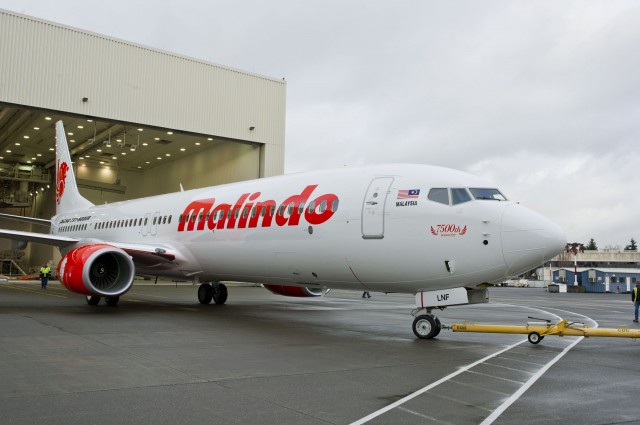
737 Number 7500 rolls out of the paint hangar destined for Malindo Air. Photo from Boeing
Today, the 7,500th 737 (9M-LNF) was delivered to Malindo Air. Malindo Air is a joint venture airline between Lion Air of Indonesia and the National Aerospace and Defense Industries (NADI) of Malaysia and the airline name takes after the two countries in the partnership (Malaysia & Indonesia).
Set to begin operations in May of this year, the airline will receive 12 737-900ERs with plans to increase this number in the future. Based out of Kuala Lumpur the airline will service domestic flights within Malaysia to begin and expand to other South East Asian Countries.
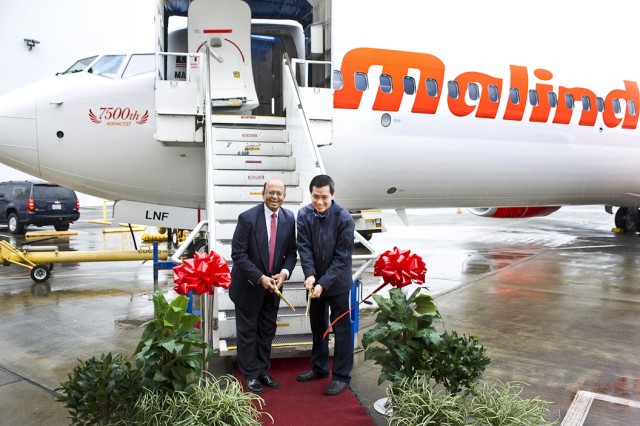
Dinesh Keskar, senior vice president of Asia Pacific and India Sales, Commercial Airplanes cuts the ribbon with Capt. Darsito Hendro S., chief operating officer of Malindo Air to celebrate the delivery. Photo: Boeing
The aircraft delivered to Malindo air is fitted with the new Boeing Sky Interior which brings in the new modern designed interior similar to the Boeing 787 with LED lighting, larger pivoting overhead bins and a greater feeling of spaciousness.
This is a far cry from the first 737, which was delivered to Lufthansa in 1967.
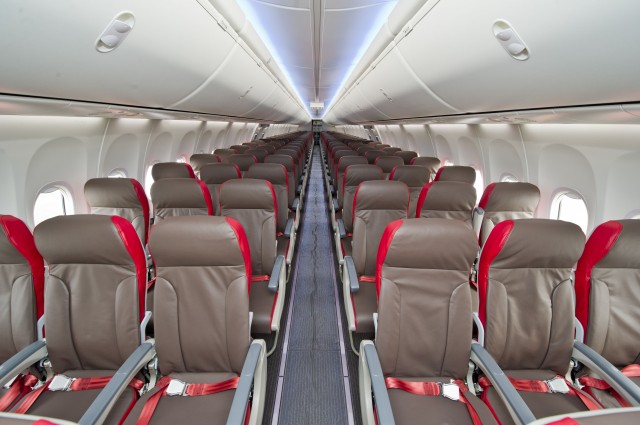
The Economy Cabin of the Malindo 737-900ER – Photo: Boeing
To help fulfill the back log of orders, Boeing has recently increased their production of 737s from 35 per month to 38, heading towards the 2014 goal of 42 — that’s roughly 1.3 aircraft per day.
Boeing has been able to up this production rate by redesigning their process and changing the way the aircraft are produced on site in Renton.
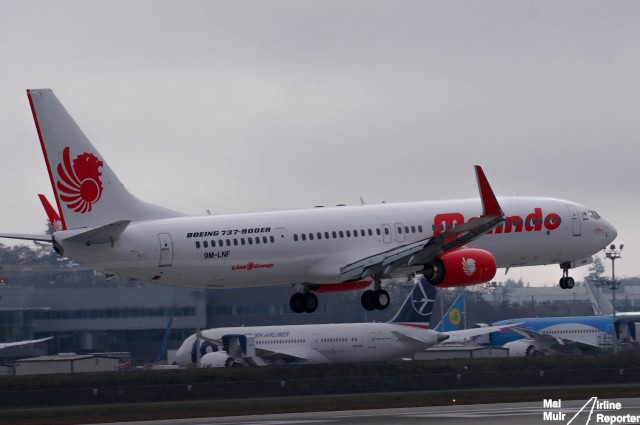
Malindo Air’s 737-900ER prior to touching down at Everett during a test flight – Photo: Mal Muir | AirlineReporter,com
The production increase is timed well. On the 19th, Boeing signed another large order with Ryanair for another 175 Boeing 737NG aircraft putting the backlog up even higher.
Think Boeing can end up delivering 18,000 aircraft someday? 7500 aircraft down, only 10500 to go!
 |
This story written by…Malcolm Muir, Lead Correspondent. Mal is an Australian Avgeek now living and working in Seattle. With a passion for aircraft photography, traveling and the fun that combining the two can bring. Insights into the aviation world with a bit of a perspective thanks to working in the travel industry.@BigMalX | BigMal’s World | Photos |
A little after 5:00am EST this morning, Boeing let the cat out of the bag: Ryanair is set to order 175 Boeing 737-800’s, which is the largest Boeing airplane order in Europe to date. Although an impressive order, the news was surely not breaking, since rumors of the order have been circulating for a while.
“This agreement is an amazing testament to the value that the Next-Generation 737 brings to Ryanair,” said Boeing Commercial Airplanes President & CEO Ray Conner. “We are pleased that the Next-Generation 737, as the most efficient, most reliable large single-aisle airplane flying today, has been and will continue to be the cornerstone of the Ryanair fleet. Our partnership with this great European low-cost carrier is of the utmost importance to everyone at The Boeing Company and I could not be more proud to see it extended for years to come.”
BONUS: The five stages passengers go through when flying ultra low-cost carriers
Currently, Ryanair operates a fleet of over 300 737-800’s and it is expected that these new aircraft will help them expand their operations. When asked if Michael O’Leary, the CEO of Ryanair, if there were plans for long haul operations, he stated, “I don’t see an opportunity for the next two to three years.” In proper O’Leary style (who is not known to act like your typical CEO), stated that he was, “drunk at the time,” when asked how much he spent on the price of the aircraft.
When O’Leary was asked why New York City was chosen as the location of the announcement, he jokingly replied it was to help divert attention from the 787 within the US. He then clarified that about 50% of the airline’s shareholders are located on the east coast of the US. O’Leary stated he was planning on attending a few shareholder meetings to assure folks that the airline is not planing to start growing like “gangbusters,” and that they plan to have a more controlled growth.
This order also means that the Boeing 737NG will continue to be produced next to the 737 MAX for quite sometime. “As today’s announcement demonstrates, there is still significant demand for the Next-Generation 737,” Linda Lee, 737 Program Communications explained to AirlineReporter.com. “This demand is the reason we decided to boost production rates to 42 per month starting the 2nd quarter of 2014.”
Yesterday, Boeing had sent out notification of the announcement today and there was quite a bit of speculation, but now we know. We were hoping for something a bit more glitzy. I mean even, seeing the Ryanair logo on the new MAX winglet would be more exciting. I guess overall this is good news for both Boeing and Airbus right? Where an order for 175 airplanes from one airline just isn’t as exciting as it used to be?
David Parker Brown and Jason Rabinowitz contributed to this story. Also catch additional background information on Airchive.com.
TWITTER PHOTOS FROM THE RYANAIR 737 PRESS CONFERENCE:
[nggallery id=41]
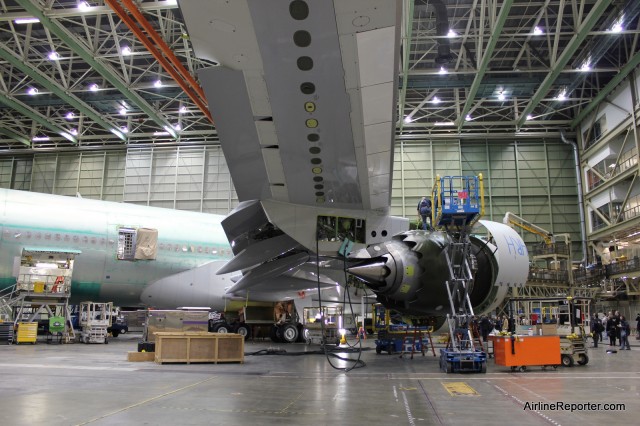
A Boeing 747-8 Intercontinental on the factory floor in Everett.
I love a good mystery. Today Boeing sent out a media advisory saying that tomorrow there will be an event in New York City to, “announce a significant airplane purchase agreement.” Now, what could this be?
The release does not say much, but gives away two interesting details. First, it will be held at a very nice hotel. I don’t want to name the exact hotel, but if I were to try and get a room there tomorrow, the cheapest is over $600.00 and the Penthouse is about $10,000. Not your Motel 6.
Also Ray Conner, President and CEO, Boeing Commercial Airplanes will be at the announcement as well. He doesn’t really show up to many order announcements, so this is something special.
So who will be the airline and what aircraft will they be ordering? Some of my thoughts:
- The venue is nice. I think this eliminates most low cost carriers, at least those in the US. Actually, I would be surprised if this was a US carrier at all. The only US carrier, who would be making a Boeing purchase and announcing in NYC I could see is Delta. But my bet is a foreign carrier.
- My guess is the order will be significant. Either with the number of planes or aircraft type. There have been some pretty large numbers of 737 orders already and it would probably need to be significant for this sort of announcement.
- Honestly, I hope that it is an order for the 747-8 Intercontinental — especially from a US carrier. There haven’t been very many and additional orders would call for celebration.
- I wouldn’t see this being an order for the 787 Dreamliner. It is still a sore topic and not currently flying.
- I think the Boeing 737 MAX is a great airplane, but no offense, the order announcements are not as exciting anymore. I am kind of hoping for a different aircraft type.
- A MAX order from JetBlue (who is based in NYC) would excite me, but I do not see that happening.
- Could this be a combo? Boeing could officially announce the 777X and the first airline to order it? It seems a bit early, but it would take some attention away from the 787 and help to move Boeing forward.
Stay tuned. @AirlineFlyer will be reporting for @AirlineReporter in New York City tomorrow and follow both Twitter accounts for the announcement. The event is set to start at 10:15am EST. Until then…
WHAT DO YOU THINK? Who do you think the airline will be? What aircraft will they order? Leave your thoughts in the comments.
Update: Reuters is reporting that they are hearing Ryanair will announce an order for 150 Boeing 737 NG’s tomorrow. Sure, great for Boeing to keep their 737NG (which is still a great plane) line going. Also would be good for Ryanair to finally be able to add more aircraft and routes, but I hope that this is not the announcement. Just not very exciting or sexy — give me some wide bodies here.
Also, the location of a posh hotel does not make sense for Ryanair, since they want to be seen as an ultra low-cost carrier. The biggest question for me is: Why New York City? Now, if they are announcing the 737 order and plans to fly to NYC, then I am interested for sure.
I am going to say that I do not think Ryanair will be involved with tomorrow’s announcement.
Update2: And I was wrong (hey it happens). A bit after 2am PST, Boeing sent out a press release giving a large preview of their announcement.
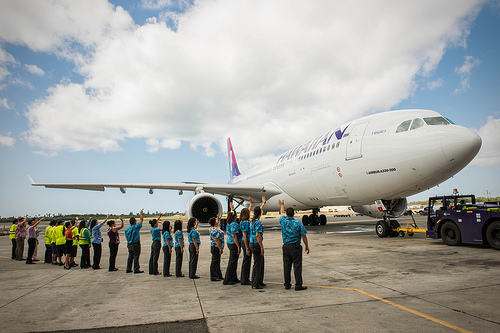
Hawaiian Airlines Airbus A330 receiving a nice farewell. Photo from Hawaiian Airlines.
This past week, Hawaiian Airlines launched another new route to its network: Honolulu to Auckland, New Zealand. The new service will use their 294-seat Airbus A330-200.
The new service will be three days a week; Monday, Wednesday and Friday from Honolulu (HA 445) and Tuesday, Thursday and Saturday from Auckland (HA 446). This new route makes Hawaiian the only US carrier to serve Auckland.
’œWe have been delighted by the interest in our new service, both here at home and in New Zealand,’ said Mark Dunkerley, Hawaiian’s president and CEO. ’œThe deep cultural connections between our islands and the islands of Aotearoa make New Zealand a natural destination for Hawaiian and for our singular brand of authentic Hawaiian hospitality.’

Hawaiian Dancers celebrate the New Zealand flight. Photo from Hawaiian Airlines.
’œThe United States is a vital market for New Zealand leisure and business travel, and is a key focus for our marketing efforts given the significant potential for growth that exists,” Tourism New Zealand’s Chief Executive Kevin Bowler stated.
This is the first of three new services announced to launch this year, along with Sendai, Japan and Taipei, Taiwan. In the last couple of years the airline’s aggressive expansion has included numerous routes to Japan, South Korea, Philippines, Tahiti, American Samoa and increased service to Australia.
The inaugural flight of HA 445 was celebrated with gate side festivities that included Hawaiian music and hula, a performance honoring the Maori culture and a traditional Hawaiian blessing
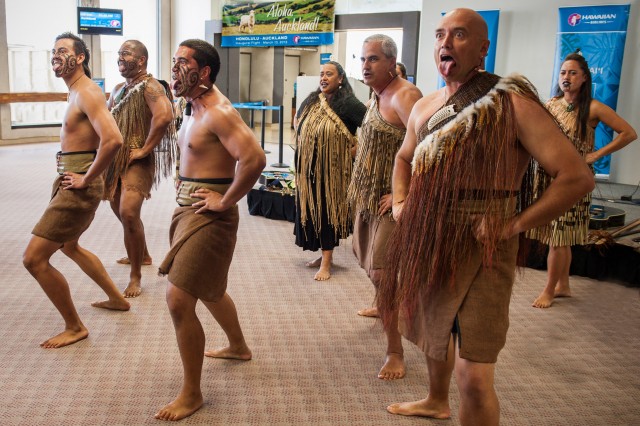
Hawaiian Airlines Maori Dancers during inaugural celebration. Photo from Hawaiian Airlines
Hawaiian Airlines has also announced that it plans to move up its Portland to Honolulu Airbus A330-200 launch date as it is taking earlier than expected delivery of new aircraft. The route is currently flown using a Boeing 767. Portland can now expect the A330 to start service on April 20th, which is about three weeks early.
The airline has been in the process of replacing their aging Boeing 767-300’s and has also announced orders for the Airbus A321neo as they continue their rapid expansion across the Pacific.
 |
This story written by…Brandon Farris, Correspondent.
Brandon is an avid aviation geek based in Seattle. He got started in Photography and Reporting back in 2010. He loves to travel where ever he has to to cover the story and try to get the best darn shot possible.
@BrandonsBlog | RightStuffPhotography | Flickr |








